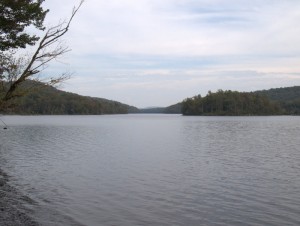
Moshier Reservoir
The following is the third part of a report on the fourth day of a bushwhacking trip through the interior of the southern portion of the Pepperbox Wilderness. The majority of the trip follows along streams and beaver vlys with the exit from the area following a marked herd path from the wild interior of this wilderness area. Highlights along the trip included the Threemile Beaver Meadow, Bear Pond, Moshier Creek and Moshier Reservoir. The third and final part of the fourth day consisted of me following along the shore of Moshier Reservoir.
Date: September 3, 2010
Length: 0.41 miles (2.29 miles cumulative)
Difficulty: Easy
As I followed along the shore of the arm of Moshier Reservoir that ended at the identically-named creek I noticed a vast amount of beaver activity. An industrious beaver (or beavers) chewed off every young American beech tree a foot or so from its base. This left the forest along the shoreline of the reservoir very open with an almost park-like setting. This gave me a beautiful view of the reservoir but the forest-penetrating sunshine made walking through this area hot and rather unpleasant. The many Punji spikes left behind by the beaver required some cautious footwork so as not to fall and become impaled.
Since I was heading northwest to a beaver vly just east of Threemile Beaver Meadow the following morning, I planned on camping somewhere along the northwest cove along the reservoir shore just south of where Moshier Creek entered the reservoir. I thought state campsites existed along the shore of the reservoir and, if so, planned on making use of one for the night.
With lunchtime quickly approaching I located a nice peninsula and temporarily unpacked the necessary stuff for a leisurely lunch. While I munched on my tuna fish sandwich I listened to the weather report as the early-morning forecast of a stormy night with high winds left me a little apprehensive. The weather forecast seemed to be a little better than earlier in the week with less rain and no mention of windy conditions. The current weather consisted of mostly sunny skies with some high clouds and stiff winds. The open shoreline and wind made for a pleasant bug-free lunch.
After lounging around for an inordinate amount of time I decided to take a quick dip in the water to clean off my body and my hiking clothes. I slipped into my shorts and Crocs Caymans (brought for stream crossing and bathing), eased myself over some roots and walked into the relatively warm water carrying my filthy hiking clothes. When I finished my bathing and laundry, I hung my wet hiking clothes on the nylon food line at the water’s edge hoping the sunshine and wind would quickly dry them. Unfortunately soon after hanging the dripping wet clothes on the line the sky clouded over and the wind diminished. Damn clouds.
View Day four, part three in a larger map
After hanging the laundry (point #56), I removed my Sawyer inline filter from my Platypus 3L Big Zip Reservoir
in preparation for using the reservoir as a shower to shampoo my hair for the first time in four days. With the large collapsible reservoir filled with water I moved back into the forest away from the shoreline the required 150 feet for washing.
Finally having all my chores done I sat by the shore of the reservoir and relaxed. Soon I would have to search for a camping site back from shore and make some dinner. A wood duck flew from the east over the reservoir and right to the edge of the water not too far south of my location. Pulling out my Leica Ultravid 8×20 I watched the wood duck that seemed entirely oblivious to my presence.
As the sky started to darken with clouds I sprang into motion and searched for a camping site back into the woods over a small rise. Finally after rejecting several flat areas because of precariously located widow-makers I found an acceptable site for my Golite Cave (point #57). Unfortunately after setting the tarp up the site proved to be less flat than it originally appeared. The increasingly threatening clouds overhead left me little choice though.
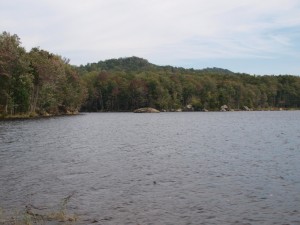
Moshier Reservoir
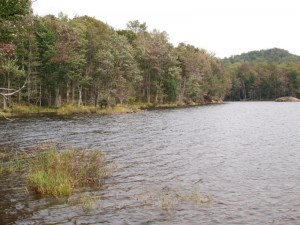
Moshier Reservoir
While I returned to the shoreline with all my dinner preparation equipment the watchband on my ancient watch broke. Thankfully I was able to retrieve the watch although the pin holding the watchband on was a casualty. Without a functioning wristband the watch was relegated to my pocket for the remainder of my trip.
When I was preparing my dinner I was visited by an agitated beaver. The beaver was obviously not pleased about my presence as it continuously slapped its tail on the surface of the water in an attempt to chase me off. It did not work. The beaver’s lodge was to the west of my direction, which may have contributed to the poor rodent’s agitation. After a while he gave up his attempt and went about his business disappearing off in the direction of the mouth of Moshier Creek.
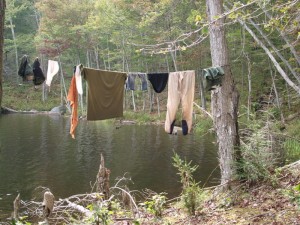
Laundry at Moshier Reservoir
After dinner was completed I brought all my equipment up to my camping spot for the evening. Once everything was settled I returned to the shoreline with my binoculars, Olympus Evolt E420 digital camera and Petzl e+LITE headlamp
with the intention of staying until around 8 PM.
The sky was mostly cloudy now with only occasional areas of blue. It was still hot and humid but the wind had died down to a great extent. The beaver was still swimming around the area but appeared to have accepted my presence now as the tail-slapping behavior failed to return.
While I sat at the edge of the water there were numerous happenings to hold my interest. A log slowly floated from out in the reservoir toward my location. Fish jumped out of the water in search of low-flying insects. Gunshots rang out briefly disturbing the calm. A drab warbler flew into the tree above my head but in the dim light identification to species was impossible. With the diminished winds the mosquitoes returned in force and threatened my peaceful daydreaming. At least three bats engaged in aerial acrobatics alternating between chasing flying invertebrates and each other. A motor roared to the south and then quickly receded. The wind picked up and the sky darkened to the southwest.
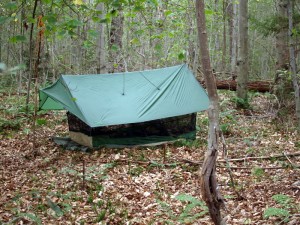
My campsite near Moshier Reservoir
Just before 8 PM I made a mad dash back to my tarp as the wind picked up and a nasty dark cloud appeared overhead. In twenty minutes, while I was safely cloistered away under my tarp the winds died down again and no rain appeared. Regardless, I set my alarm clock on my radio for 5 AM and I settled in and tried to fall asleep early.
By 9 PM a thunderstorm moved into the area with the worst stuff sounding as if it passed to the north followed by another round to the south later on. Luckily I missed the worst part of the storm. This suited me fine since I have been apprehensive about being in a backcountry thunderstorm since surviving the 1995 microburst in the Five Ponds Wilderness. Even more rain moved into the area around midnight but it was not accompanied by any thunder or lightening. The rain sounded heavy at times but since my Backpacker’s pantry collapsible pack bowl was left out, and contained little water in the morning, the sound must have been mostly due to the wind.
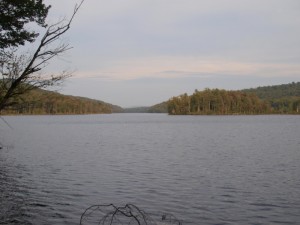
Dusk on Moshier Reservoir
As usual for the backcountry I slipped in and out of sleep often during the night. At some point I heard a barred owl hooting multiple times from far away and a deer snorting nearby. The wind roared through the canopy until the early morning hours.
Sometime during the early morning hours the temperature and humidity finally decreased, which made for comfortable sleeping conditions just before I was set to wake up and meet my final day in the Pepperbox Wilderness.
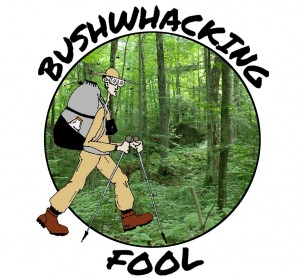



B.& S.Moshier
January 21, 2011 at 7:48 pm
My last name is Moshier and I have never heard of the Moshier Creek or Reservoir. Do you know who it is named for? A specific Moshier? Please email when you can. I found your entry extremely interesting.
bushwhackingfool
January 22, 2011 at 12:28 pm
Not only is there a Moshier Creek and Reservoir there is also a road, a series of ponds and a boat launch named Moshier. I did a little research about the identity of their namesake and I found a book titled “Descriptive guide to the Adirondacks” by Edwin R. Wallace that indicated they were named after a distinguished sportsman from Lowville that discovered the ponds. Unfortunately the short excerpt from Google books did not name him but here is the link. This book sounds like it has a lot of interesting information about the area so maybe I will buy it.
I am glad you enjoyed reading my blog.